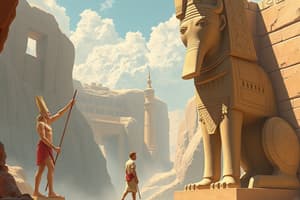Podcast
Questions and Answers
What period does the depiction of Akhenaten, Nefertiti, and three daughters belong to?
What period does the depiction of Akhenaten, Nefertiti, and three daughters belong to?
- Old Kingdom
- Amarna Period (correct)
- Middle Kingdom
- New Kingdom (correct)
What materials were used in this sculpture?
What materials were used in this sculpture?
Limestone
What is different about this depiction of the pharaoh compared to previous ones?
What is different about this depiction of the pharaoh compared to previous ones?
Doesn't follow conventional depictions; it is not idealized and looks more feminine.
What type of sculpture is this work?
What type of sculpture is this work?
Low relief comes out of the background slightly, while _____ is carved into the background.
Low relief comes out of the background slightly, while _____ is carved into the background.
Describe the scene of Akhenaten and Nefertiti in this work.
Describe the scene of Akhenaten and Nefertiti in this work.
How is the divine portrayed in this work?
How is the divine portrayed in this work?
What symbolizes Aten?
What symbolizes Aten?
What is Akhenaten holding, and what does it represent?
What is Akhenaten holding, and what does it represent?
What significant changes occurred during the reign of Akhenaten?
What significant changes occurred during the reign of Akhenaten?
What was the function of this work?
What was the function of this work?
What happened to Akhenaten's changes once he died?
What happened to Akhenaten's changes once he died?
Flashcards
Amarna Period
Amarna Period
A period in Egyptian history marked by King Akhenaten's reign, known for its unique art and religious reforms.
Sunken Relief
Sunken Relief
A type of relief sculpture where the figures are carved into the surface, creating a recessed effect.
Akhenaten Family Relief
Akhenaten Family Relief
A limestone sculpture depicting King Akhenaten, his wife Nefertiti, and their three daughters.
Aten
Aten
Signup and view all the flashcards
Ankh
Ankh
Signup and view all the flashcards
Akhetaten
Akhetaten
Signup and view all the flashcards
Amarna Art Style
Amarna Art Style
Signup and view all the flashcards
Polytheism
Polytheism
Signup and view all the flashcards
Religious Reforms of Akhenaten
Religious Reforms of Akhenaten
Signup and view all the flashcards
Move of the Capital
Move of the Capital
Signup and view all the flashcards
Return to Traditional Practices
Return to Traditional Practices
Signup and view all the flashcards
House Altar
House Altar
Signup and view all the flashcards
Study Notes
Akhenaten, Nefertiti, and Three Daughters
- Originated during the Amarna Period, part of the New Kingdom, specifically the 18th Dynasty.
- Created between 1353-1335 BCE, utilizing limestone as the primary material.
Visual Analysis
- Depiction diverges from traditional male pharaoh portrayals, featuring a more naturalistic and intimate scene with family.
- A notable lack of idealization is evident, portraying Akhenaten with a more feminine physique and soft features.
Sculpture Type
- Classified as sunken relief, where figures are carved into the background rather than projecting outward.
Artistic Characteristics
- The scene captures a personal moment between Akhenaten, Nefertiti, and their daughters, breaking from previous formal royal portraits.
- Akhenaten's posture and expression convey a relaxed interaction with his family.
Divine Representation
- Illustrates the sun god Aten with realism; rays emanate from the sun, ending in small ankhs symbolizing life.
- Akhenaten's holding of an ankh signifies iconography related to eternal life.
Cultural Changes Under Akhenaten
- Capital was relocated from Thebes to Akhetaten as part of a broader cultural shift.
- Transitioned Egypt’s religious structure from polytheism to a singular worship of Aten.
- Altered representations of human figures in art, emphasizing realism.
Function and Context
- This work served a functional purpose as part of a house altar, emphasizing its domestic and personal significance.
- After Akhenaten's death, there was a reversion to previous practices, including the restoration of polytheism and traditional artistic conventions.
Studying That Suits You
Use AI to generate personalized quizzes and flashcards to suit your learning preferences.
Description
Explore key concepts from the Amarna Period through flashcards focused on Akhenaten, Nefertiti, and their daughters. This quiz highlights artistic representations and materials used during the New Kingdom, emphasizing how this depiction differs from previous portrayals. Test your knowledge on this fascinating era of ancient Egyptian history.




